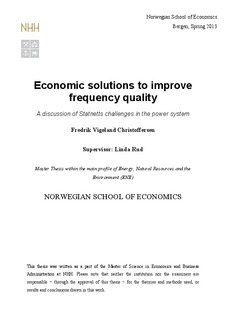| dc.description.abstract | The frequency of a power system can be compared to the heartbeats of a human. However,
unlike for the human heart rate, it is vital that the frequency is kept stable at all time.
Frequency deviations occur when the frequency is not kept stable. The deviations are used to
measure frequency quality, which is an indication of the quality of power supply. The
frequency quality has decreased the last ten years. This thesis identifies challenges of
providing a sufficient frequency quality, and discusses economic solutions that Statnett as the
TSO can implement to meet these challenges. The first part of the thesis presents the energy
system. Based on this discussion we identify that rapid load changes, light system operation
and wind power production represent important challenges in providing a sufficient frequency
quality. We further discuss various solutions to deal with these challenges, focusing on
economic based solutions of market design and incentives, rather than new technical
solutions. As the energy system is interlinked and complex, the thesis takes a broad
perspective. Thus, the thesis identifies and discusses several possible measures that we argue
will benefit the future frequency quality of the system: - changing the time of trading units
and interconnector ramping rules, - strengthening the intraday market, - introducing wind
power brokers, - introducing new products in the option market for manual reserves, and -
facilitate for flexible consumption. | no_NO |
